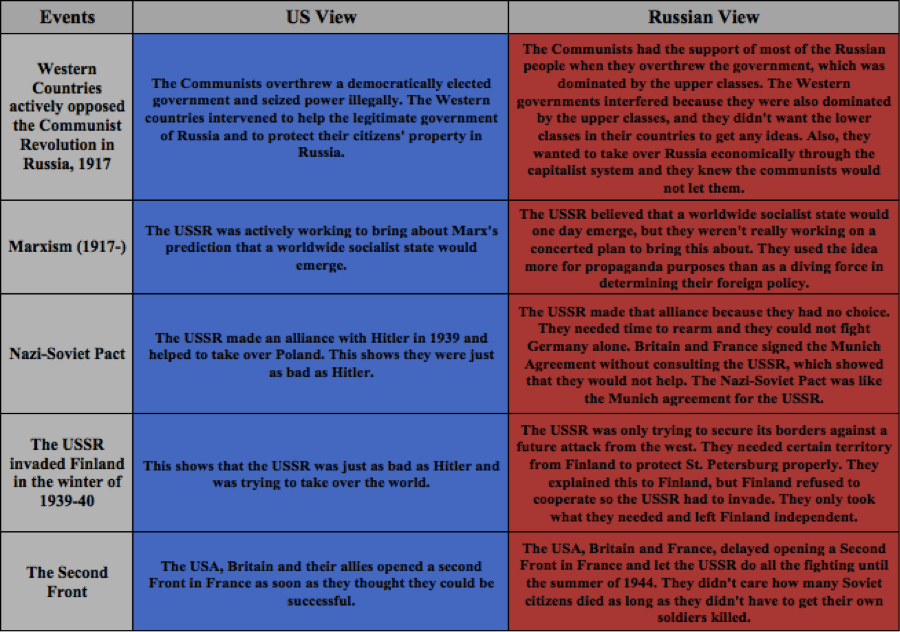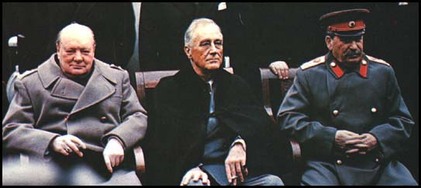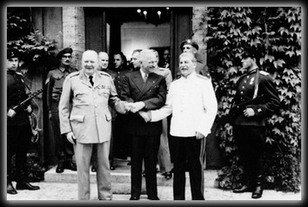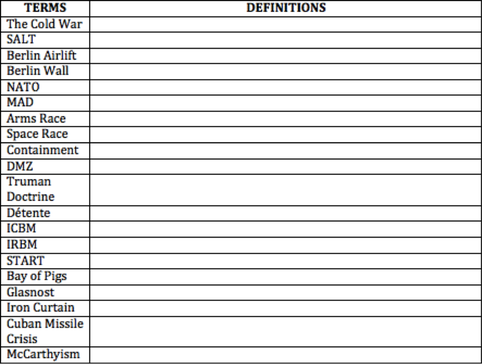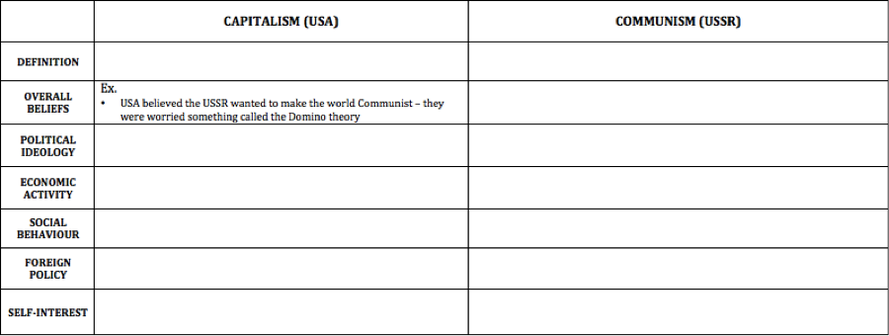Origins of the Cold War: Introduction
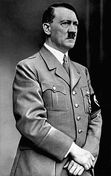
"With the defeat of the Reich and pending the emergence of the Asiatic, the African, and perhaps the South American nationalism, there remain in the world only two Great Powers capable of confronting each other-the United States and Soviet Russia. The laws of both history and geography will compel these two Powers to a trial of strength, either military or in the fields of economics and ideology. The same laws make it inevitable that both Powers should become enemies of Europe. And it is equally certain that both these Powers will sooner or later find it desirable to seek the support of the sole surviving great nation in Europe, the German people."
-Adolf Hitler, 1945
-Adolf Hitler, 1945
Background
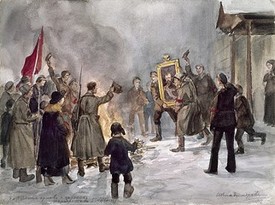
It is easy to say that the developments during World War II (the creation and victory of the Grand Alliance and the Atomic Bombs dropped in Hiroshima and Nagasaki) were clearly the imminent signals to the coming of the Cold War. Too often in our study of the nature and impacts of World War II, we assume that the participants (the Americans and the USSR) should have known or foreseen what was about to unravel. It can be argued, however, that the decade of the 1940’s brought about events, forces, and technology that were clearly unimaginable, but that these events were already the by-product of a long-standing feud or mistrust dating back to the 1917 Russian Revolution.
The following table below briefly outlines the peculiar relationship between the USSR and the United States of America and can be traced as far back as the 1917 Russian Revolution and up until the latter part of World War II.
The following table below briefly outlines the peculiar relationship between the USSR and the United States of America and can be traced as far back as the 1917 Russian Revolution and up until the latter part of World War II.
|
As you can see, the dysfunctional relationship between the USA and the USSR can easily be traced to the Bolshevik Revolution that toppled what many Western countries considered as a "democratically elected government" in 1917. Fast forward to the latter half of World War II and the bickering and mistrust between the two states continues despite the public facade they exhibited (read paged 454 to 457 to the text 20th Century World History for more details) during the 1945 Yalta (February) and Potsdam (July) Conferences.
|
Ultimately, the relationship between the USA and the USSR would eventually lead the post-World War II world into four decades of power struggles between these two superpowers that "changed not only the nature of global politics but also the daily lives of people all over the world" (page 453 of the text 20th Century World History).
|
Thus, in order for us to understand why the two remaining superpowers after World War II disliked and distrusted each other, it is important for us to study the differing political, economic and social ideals or philosophies of these two superpowers, which eventually polarized the world into two major sphere of influence, thereby initiating four and a half decades of hostility known commonly as the Cold War.
Task 1: Cold War Definitions
Before we begin our study of the origins of the Cold War we must first familiarize ourselves with the multitude of terminologies and acronyms that we will encounter in this unit. The following list below is just a sample of the many concepts that will be discussed and analyzed throughout this unit. As we progress with out investigation of the Cold War, more terminologies, acronyms and concepts will be added onto the list below.
Before we begin our study of the origins of the Cold War we must first familiarize ourselves with the multitude of terminologies and acronyms that we will encounter in this unit. The following list below is just a sample of the many concepts that will be discussed and analyzed throughout this unit. As we progress with out investigation of the Cold War, more terminologies, acronyms and concepts will be added onto the list below.
|
Instructions
|
Further Reading
- Chapter 9 of the text 20th Century World History (pages 451 to 458).
Task 2: Ideological Differences
The Cold War was more than just a war between two countries. It was a war between two ideologies: Communism and Capitalism, and the USA and the USSR both feared each others' ideology. The organization of their world was based on very different principles in politics, economic activity and lifestyle (society). The US being capitalist and a democracy (freedom and a two-party) and the USSR being a communism and a dictatorship (had secret police and was a one-party state.) Both sides had reasonable and sensible, but totally opposite viewpoints. With such differing beliefs, it is inevitable that they would disagree.
The Cold War was more than just a war between two countries. It was a war between two ideologies: Communism and Capitalism, and the USA and the USSR both feared each others' ideology. The organization of their world was based on very different principles in politics, economic activity and lifestyle (society). The US being capitalist and a democracy (freedom and a two-party) and the USSR being a communism and a dictatorship (had secret police and was a one-party state.) Both sides had reasonable and sensible, but totally opposite viewpoints. With such differing beliefs, it is inevitable that they would disagree.
Instructions
1. Read chapter 1 of the text History - 20th Century World: The Cold War and chapter 9 of the text 20th Century World History (pages 451 to 458).
2. Download the following document titled "ORIGINS OF THE COLD WAR - IDEOLOGICAL DIFFERENCES Worksheet.docx".
3. Using the information from chapter 1 and further research, complete the following table below.
4. Feel free to use ANY resources possible, but DO NOT COPY AND PASTE.
5. Feel free to use the table below and adjust the size of each box according to the amount of information you have provided.
6. Read the marks scheme below the list in order to understand how the activity will be graded.
7. Once completed, save the title the file in the following manner: "ORIGINS OF THE COLD WAR - IDEOLOGICAL DIFFERENCES Worksheet - (Your Full Name).docx". If you are using Pages, follow the same format.
8. Once you finish titling the completed work, save the file on a USB flashdrive or stick (or portable hard drive) and submit it to me via these medium (DO NOT EMAIL THE WORK).
THE ORIGINS OF THE COLD WAR - IDEOLOGICAL DIFFERENCES Worksheet.docx Download File
1. Read chapter 1 of the text History - 20th Century World: The Cold War and chapter 9 of the text 20th Century World History (pages 451 to 458).
2. Download the following document titled "ORIGINS OF THE COLD WAR - IDEOLOGICAL DIFFERENCES Worksheet.docx".
3. Using the information from chapter 1 and further research, complete the following table below.
4. Feel free to use ANY resources possible, but DO NOT COPY AND PASTE.
5. Feel free to use the table below and adjust the size of each box according to the amount of information you have provided.
6. Read the marks scheme below the list in order to understand how the activity will be graded.
7. Once completed, save the title the file in the following manner: "ORIGINS OF THE COLD WAR - IDEOLOGICAL DIFFERENCES Worksheet - (Your Full Name).docx". If you are using Pages, follow the same format.
8. Once you finish titling the completed work, save the file on a USB flashdrive or stick (or portable hard drive) and submit it to me via these medium (DO NOT EMAIL THE WORK).
THE ORIGINS OF THE COLD WAR - IDEOLOGICAL DIFFERENCES Worksheet.docx Download File
Suggested Readings
Here are a couple of links that explains the difference between the two systems.
Here are a couple of links that explains the difference between the two systems.
Exam Questions
Paper 2: Topic 5 - The Cold War
May Exams
Paper 2: Topic 5 - The Cold War
May Exams
- Assess the part played by differing ideologies in the origin of the Cold War. (May 2005 & 2007)
- Analyse the origin of East-West rivalry and explain why it developed into the Cold War. (May 2008)
- Analyse the responsibility of the USA and the USSR for the outbreak and development of the Cold War, up to 1949. (Nov 2006)
- “The breakdown of East-West relations was due to the failure of both sides to appreciate the fears of the other.” With reference to the period 1945–53, to what extent do you agree with this statement? (Nov 2007)
- “The importance of ideology as the major cause of the Cold War has been greatly exaggerated.” To what extent do you agree with this statement? (Nov 2008)
- “The events of 1945 marked both the high point and the breakdown of East–West relations.” To what extent do you agree with this statement? (Nov 2009)
- “The Potsdam Conference marked the end of the wartime alliance and laid the foundations for post-war hostility.” With reference to the period up to 1949, to what extent do you agree with this statement? (Nov 2011)
